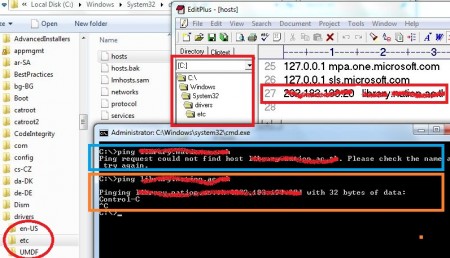
หากต้องการสร้าง host name ขึ้นมาใน Windows 7
เช่น burin.hello.com
บล็อกที่มีเนื้อหาเน้นทางด้านเทคโนโลยีสารสนเทศ

หากต้องการสร้าง host name ขึ้นมาใน Windows 7
เช่น burin.hello.com
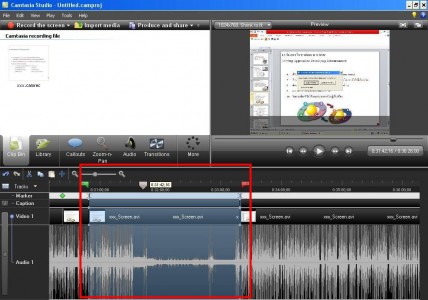
หนึ่งในจุดเด่นของ camtasia ที่ผมชอบมาก คือ split และลบบาง shot ได้ง่าย (Remove some scene) ตัวอย่างนี้เกิดขึ้นในระหว่างที่บันทึกจอภาพของ powerpoint แล้ว มีเสียงโทรศัพท์เข้า ต้องหยุดบันทึก และไปรับโทรศัพท์ เพราะอยู่คนเดียว แต่ผมก็ต้องบันทึกต่อ จะให้เริ่มใหม่ตั้งแต่ต้นคงไม่สะดวก เพราะเป็น slide สุดท้ายแล้ว เมื่อเสร็จธุระก็กลับไปกดปุ่ม continue บันทึกต่อให้จบ จากนั้นก็ใช้การ split เลือกช่วงที่ไม่ต้องการ แล้วลบออกไป จากนั้นก็ produce & share ใหม่ เพียงเท่านี้เองครับ ไม่ซับซ้อน และไม่ต้องเริ่มต้นใหม่
พฤติกรรมการใช้ camtasia ของผม คือ ใช้เพื่อนบันทึกเหตุการณ์บน powerpoint เพียงอย่างเดียว เรียกว่าใช้แต่ add-ins เท่านั้น บันทึกเสร็จก็ produce & share เป็น mp4 เลย แฟ้มที่ได้อาจนำไปใช้ในเครื่องบริการที่ใดก็ได้ .. สำหรับแผนนำไปใช้มีดังนี้ แผนแรกคือลงซีดีแจกนักศึกษา แผนสองคือลง youtube.com กับ dropbox แผนสามคือวางไว้ที่เครื่องบริการ โดยใช้ flash player เป็นตัวแสดงคลิ๊ปออกทาง browser
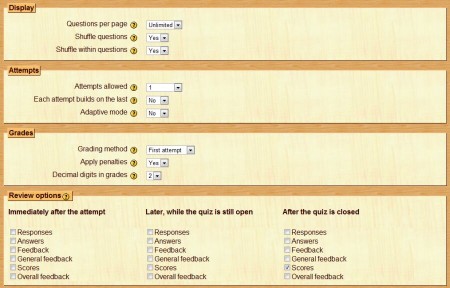
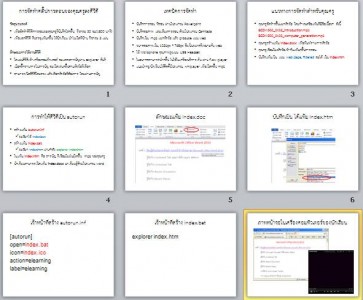
2 ก.ค.55 จะทำคลิ๊ปสอนสร้างแผ่น dvd autorun ที่คุณครูบันทึกการสอนของคุณครูผ่าน powerpoint ด้วยโปรแกรม camtasia สักหน่อย เตรียมได้ถึง pptx ครับ จึงจับจอภาพมาให้ดู .. ผมถือเป็นการบันทึกความก้าวหน้า .. ในแผนที่จะทำ คือ นำ เสนอให้คุณครูทราบกระบวนการ หรือขั้นตอนในการจัดทำ มีขั้นตอนเบื้องต้น ดังนี้ 1) ตั้งชื่อแฟ้มอย่างไร หลังบันทึกคลิ๊ปกว่าร้อยตอน 2) เตรียมสารบัญอย่างไรเชื่อมโยงคลิ๊ปทั้งหมด 3) แล้วทำอย่างไรให้เป็นแผ่น autorun 4) เมื่อแจกให้นักเรียนแล้ว นักเรียนจะเห็นอะไรที่บ้าน .. ซึ่งคุณครูอาจต้องการทีมไอทีในการให้คำปรึกษาทุกขั้นตอน กว่าจะถึงขั้นที่ 4 สำหรับผมก็จะมีคุณเปรม อุ่นเรือน ที่ช่วยผมทดสอบจัดทำ DVD กว่าจะลงตัว ก็ใช้ DVD ไปสามแผ่นแน่ะครับ .. ตอนนี้ลงตัวแล้ว
http://www.thaiall.com/pptx/dvd_autorun.pptx
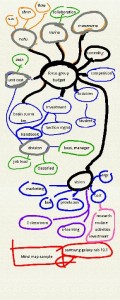
ตัวอย่าง การเขียน MindMap ด้วยมือบน Samsung Galaxy Tab 10.1 โดยใช้ บันทึกด้วยปากกา (pen memo) ที่มีมากับอุปกรณ์เขียนด้วยปลายนิ้ว แล้วพิมพ์ข้อความเข้าไปด้วยแป้นพิมพ์บนจอภาพ .. การพิมพ์ข้อความจัดยาก เพราะรับแบบตัวอักษรที่เรียงบรรทัดตามปกติ ไม่สามารถย้ายข้อความได้เหมือนวัตถุทั่วไป
+ ไดอะแกรมนี้เกิดขึ้น ขณะนั่งประชุมกลุ่มเรื่อง “budget” ว่าปัจจุบันการได้มาซึ่งงบประมาณนั้นประกอบด้วยหลายส่วน มีระบบและกลไกควบคุม ที่จะนำไปสู่การใช้สารสนเทศให้เกิดประโยชน์ และเป็นเครื่องชี้วัดความสำเร็จขององค์กรทุกประเภท เนื้อหาก็จะมีหลากหลาย เพราะเป็นการระดมสมองในเรื่องราวต่าง ๆ ที่เกี่ยวข้อง
+ งบประมาณมิใช่จุดเริ่มต้นของเรื่อง และไม่ใช่การสิ้นสุด แต่เป็นเครื่องมือในกระบวนการทำงานขององค์กร ทั้งภาครัฐ และเอกชนก็ต้องมี สำหรับหน่วยงานราชการมีการปิดงบประมาณเดือนตุลาคมของทุกปี ดังนั้นกิจกรรมต่าง ๆ จะเกิดขึ้นก่อนตุลาคมค่อนข้างหนาตา เพราะมีเกณฑ์ว่าถ้างบประมาณที่เคยขอไปใช้ไม่หมด ปีต่อไปก็จะขอไม่ได้เท่าเดิม ดังนั้นการตั้งงบประมาณ จึงเป็นเรื่องสำคัญและมีความสมเหตุสมผลอยู่ในตัว เพราะตั้งมากไปก็ไม่ได้ ตั้งน้อยไปก็จะแย่เอา
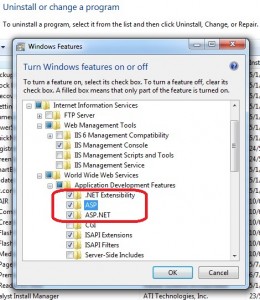
การเปิดบริการ iis7 บน windows 7 ผ่าน Control Panel, Programs and Features , Turn Windows features on or off ถ้าเลือกเปิดบริการเฉพาะ Internet Information Services จะไม่บริการ ASP หรือ ASP.NET ถ้าต้องการบริการภาษา script ก็ต้องเข้าไปเปิดบริการใน Internet Information Services, World Wide Web Services, Application Development Features เพื่อให้รองรับแฟ้ม .asp หรือ .aspx ในห้อง c:\inetpub\wwwroot
ก็ต้องเข้า Control Panel, Administrative Tools, Internet Information Services (IIS) Manager, Sites, Default Web Site, Basic Settings
การอัพโหลด รายชื่อผู้ใช้เข้าระบบอีเลินนิ่งของ moodle มีเงื่อนไข ดังนี้ 1) บรรทัดละ 1 คน 2) ทุกบรรทัดมีหนึ่งระเบียน แต่ละระเบียน แบ่งแยกด้วย , หรือเครื่องหมายแล่งแยกอื่น 3) ระเบียนแรกให้เป็นชื่อเขตข้อมูล 4) ชื่อเขตข้อมูล คือ username, password, firstname, lastname, email
ผมมีข้อมูลเป็นอีเมล และต้องการใช้ email เป็นรหัสสำหรับ login เช่น xxx@yyy.com แล้วต้องการเฉพาะ xxx จึงใช้ฟังก์ชันด้านล่างนี้
=LOWER(MID(E2,1,FIND(“@”,E2)-1))
ในโปรแกรม excel เพื่อให้ได้แฟ้ม csv
ผลทดสอบส่ง 597 คน เข้าระบบ เรียบร้อยดีครับ

16 พ.ค.55 ในระบบรายงานสถิติของ truehits.net แสดงให้เห็นว่ามีผู้ใช้ chrome จำนวนมาก จากสถิติการเข้าเว็บไซต์ของ thaiall.com เมื่อพฤษภาคม 2555 พบว่ามีผู้ใช้ chrome มากเป็นอันดับ 1 ราว 46% สลับกับ IE ซึ่งใกล้เคียงกัน 45% แต่อันดับสามคือ firefox 10% .. ซึ่งผมใช้ความรู้สึกในฐานะของสาวก firefox ตัวข้อสงสัยว่าจริงหรือ .. แต่แล้วก็พบเหตุที่ทำให้เป็นเช่นนั้น
1) เมื่อเข้าใช้บริการ google doc แล้วพบข้อความว่า browser ที่คุณใช้อยู่ไม่สนับสนุนการใช้ google doc ถ้าให้ดีควร ใช้ chrome .. เพราะขณะนี้ใช้ firefox อยู่
2) ใน imobile หรือ samsung galaxy ที่ใช้ android ต่างก็ใช้ chrome เป็น default browser แม้มีหลายค่ายให้เลือก แต่คำว่า default browser นี่ชนะมานักต่อนักแล้ว
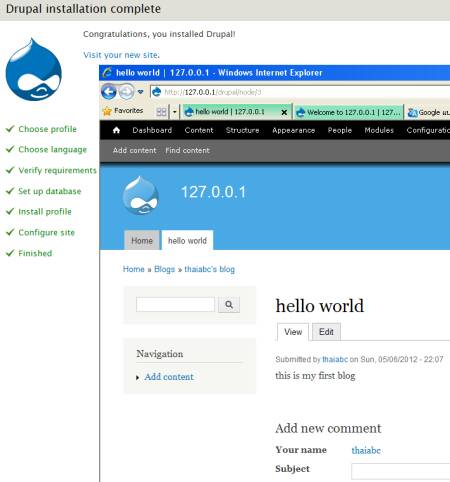
ขั้นตอนการติดตั้ง drupal ซึ่งทดสอบใน thaiabc.com มีดังนี้
1. create database = drupal ใน mysql
2. download script แล้ววางไว้ในห้อง drupal ของ root
3. เปิด http://127.0.0.1/drupal/install.php
4. เลือก standard, english
Set up database
Database name = drupal
Database username = root
Database password = ว่างไว้
5. ดำเนินการจนติดตั้งสำเร็จ
6. http://127.0.0.1/drupal
7. Create new account
username = test
8. เข้าระบบในฐานะ admin ด้วย
Username = thaiabc
Password = abc2008
9. menu, People,
click edit of “test” user
Password = test2008
Status = active
10. menu, Modules
Blog = Enabled
11. add blog or menu
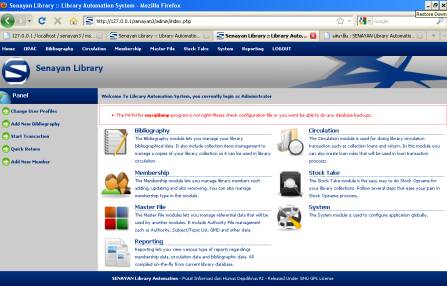
บันทึกขั้นตอน จากกิจกรรมปรับปรุงรุ่นของโปรแกรมแก้วสารพัดนึกใน thaiabc.com เป็นรุ่น 8.0 โดยเพิ่ม moodle1.9.12 จากที่มี moodle1.5 ทำให้มี e-learning ใช้ 2 รุ่นและเปรียบเทียบกันได้ เหตุผลที่เลือก 1.9 เพราะที่ thaiall.com/moodle ใช้รุ่นนี้มาปีกว่าแล้ว แต่ไม่ใช้รุ่น 2.0 ขึ้นไป ด้วยเหตุว่า backup ในรุ่น 2.0 จะนำไป restore ใน 1.9 ไม่ได้ ถ้านำ backup ของ 1.9 ไป restore ใน 2.0 นั้นทำได้ และจากการทดสอบ restore course จาก thaiall.com/moodle ในเครื่องใหม่นี้ พบว่านำมาใช้ได้ตามปกติ
—
ขั้นตอนการติดตั้ง moodle 1.9.12
1. เปิดบริการ apache2.0.52 และ mysql5.5.16
ตอนเปิดบริการในเครื่องที่ติดตั้ง skype อาจพบปัญหา port 80 ชนกันได้ครับ
2. เตรียม scripts ในห้อง /moodle19
3. สร้างห้อง /moodledoc19 เตรียมรับข้อมูลจากผู้ใช้
4. เริ่มติดตั้งด้วยการเรียก /moodle19/install.php
5. ต้องแก้ไข register_globals=Off ใน php.ini แล้วก็ restart apache
ถ้าไม่รู้ว่า php.ini อยู่ห้องใดก็เรียก function phpinfo()
6. พบขั้นตอนการติดตั้งดังนี้
– Checking your PHP settings
– Please conform the locations of this Moodle installation
Web Address = http://127.0.0.1/moodle19
Data Directory = C:\thaiabc\moodledata
– Now you need to configure the database
Type = MySQL
Host Server = localhost
Database = moodle19 (Create DB automatically)
User = root
Password = ว่างไว้
– Checking your environment
– Download language pack
– Configuration completed
– Copyright notice
– Current release information Moodle 1.9.12 (Build: 20110510)
– Setting up database : Database was successfully upgraded
– Setup administrator account.
Username = admin
password = Password#2555
– New settings – Front Page settings
Self registration = Email-based self-registration
7. ผลการเรียก http://127.0.0.1/moodle19 พบว่าปกติ
8. สร้างวิชา และ upload แฟ้มภาพ และเรียกใช้แฟ้มภาพ ไม่พบปัญหา
—
ขั้นตอนการ Restore course ของ moodle 1.9.12
1. เข้าไปในวิชาที่สร้างไว้แล้ว
2. เลือก Restore
3. เลือกแฟ้มที่ Backup ไว้จาก server อีกตัวหนึ่ง
4. เมื่อถามว่า Restore to
– Current course, deleting it first
– Current course, ading data to it
– new course
5. ทดสอบทั้ง 3 แบบ พบว่าใช้งานได้ปกติ
6. ถ้าทดสอบ new course ก็จะได้วิชาใหม่อีก 1 วิชา ไม่ทับวิชาเดิม
—
ขั้นตอนการติดตั้ง senayan3
1. เปิดโปรแกรม phpmyadmin
2. สร้าง db : senayan3 แล้วเข้าไปใน db นี้
3. สั่งประมวลผล sql 2 แฟ้มในห้อง /senayan3/sql/install
4. เริ่มจาก import แฟ้ม senayan.sql ตามด้วย sample_data.sql
5. แก้ไข sysconfig.inc.php
define(‘DB_NAME’, ‘senayan3’);
define(‘DB_USERNAME’, ‘root’);
define(‘DB_PASSWORD’, ”);
6. เข้าระบบด้วย
user: admin
password: admin
7. ทดสอบที่ http://127.0.0.1/senayan3 พบว่าใช้งานได้ปกติ
8. แก้ไขตัวแปรใน sysconfig.inc.php อีก 2 ตัวแปร
$sysconf[‘mysqldump’] = ‘c:/thaiabc/mysql/data’;
$sysconf[‘temp_dir’] = ‘c:/tmp’;
http://www.thaiall.com/blog/burin/3955/
http://slims.web.id/web/
http://sourceforge.net/projects/senayanlib/
http://www.senayan.kru-ple.com/
—
SENAYAN 3.0 stable
Core Senayan Developer :
Hendro Wicaksono – hendrowicaksono@yahoo.com
Arie Nugraha – dicarve@yahoo.com
Below are the instructions for new installation of SENAYAN :
1. Put senayan3-stable3 folder in web document root
2. create senayan database in mysql
3. Open your phpMyAdmin or mysql client utility (or other mysql manager softwares) and
run sql/install/senayan.sql inside your SENAYAN application database.
4. Re-check your database configurations and others configuration in sysconfig.inc.php.
5. If you have your own custom template, Adjust detail_template.php file or just overwrite it
with detail_template.php from default template directory